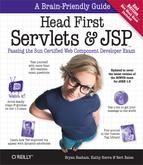Which are true about filters? (Choose all that apply.)
A.
A filter can act on only the request or response object, not both.
B.
The
destroymethod is always a container callback method.C.
The
doFiltermethod is always a container callback method.D.
The only way a filter can be invoked is through a declaration in the DD.
E.
The next filter in a filter chain can be specified either by the previous filter or in the DD.
Which are true about declaring filters in the DD? (Choose all that apply.)
A.
Unlike servlets, filters CANNOT declare initialization parameters.
B.
Filter chain order is always determined by the order the elements appear in the DD.
C.
A class that extends an API request or response wrapper class must be declared in the DD.
D.
A class that extends an API request or response wrapper class is using the Intercepting Filter pattern.
E.
Filter chain order is affected by whether filter mappings are declared via
<url-pattern>or via<servlet-name>.Given the class UserRequest is an implementation of HttpServletRequest, and given that this method in an otherwise properly defined
Filterimplementation:20. public void doFilter(ServletRequest req, 21. ServletResponse response, 22. FilterChain chain) 22. throws IOException, ServletException { 23. HttpServletRequest request = (HttpServletRequest) req; 23. HttpSession session = request.getSession(); 25. Object user = session.getAttribute("user"); 26. if (user != null) { 27. UserRequest ureq = new UserRequest(request, user); 28. chain.doFilter(ureq, response); 29. } else { 30. RequestDispatcher rd = request.getRequestDispatcher("/login.jsp"); 31. rd.forward(request, response); 32. } 33. }
Which is true?
A.
An exception will always be thrown if line 31 executes.
B.
Line 28 is invalid because
requestmust be passed as the first argument.C.
This line:
chain.doFilter(request, response)must be inserted somewhere in theelseblock.D.
This method does not properly implement
Filter.doFilter()because the method signature is incorrect.E.
None of the above.
Given a partial deployment descriptor:
11. <filter> 12. <filter-name>My Filter</filter-name> 13. <filter-class>com.example.MyFilter</filter-class> 14. </filter> 15. <filter-mapping> 16. <filter-name>My Filter</filter-name> 17. <url-pattern>/my</url-pattern> 18. </filter-mapping> 19. <servlet> 20. <servlet-name>My Servlet</servlet-name> 21. <servlet-class>com.example.MyServlet</servlet- class> 22. </servlet> 23. <servlet-mapping> 24. <servlet-name>My Servlet</servlet-name> 25. <url-pattern>/my</url-pattern> 26. </servlet-mapping>
Which is true? (Choose all that apply.)
A.
The file is invalid because the URL pattern
/myis mapped to both a servlet and a filter.B.
The file is invalid because neither the servlet name nor the filter name is allowed to contain spaces.
C.
The filter
MyFilterwill be invoked after theMyServletservlet for each request that matches the pattern/my.D.
The filter
MyFilterwill be invoked before theMyServletservlet for each request that matches the pattern/my.E.
The file is invalid because the
<filter>element must contain a<servlet-name>element that defines which servlet the filter should be applied to.Which about filters are true? (Choose all that apply.)
A.
Filters may be used to create request or response wrappers.
B.
Wrappers may be used to create request or response filters.
C.
Unlike servlets, all filter initialization code should be placed in the constructor since there is no
init()method.D.
Filters support an initialization mechanism that includes an
init()method that is guaranteed to be called before the filter is used to handle requests.E.
A filter’s
doFilter()method must calldoFilter()on the inputFilterChainobject in order to ensure that all filters have a chance to execute.F.
When calling
doFilter()on the inputFilterChain, a filter’sdoFilter()method must pass in the sameServletRequestandServletResponseobjects that were passed into it.G.
A filter’s
doFilter()may block further request processing.Which are true about the servlet Wrapper classes? (Choose all that apply.)
A.
They provide the only mechanism for wrapping
ServletResponseobjects.B.
They can be used to decorate classes that implement
Filter.C.
They can be used even when the application does NOT support HTTP.
D.
The API provides wrappers for
ServletRequest,ServletResponse, andFilterChainobjects.E.
They implement the Intercepting Filter pattern.
F.
When you subclass a wrapper class, you must override at least one of the wrapper class’s methods.
